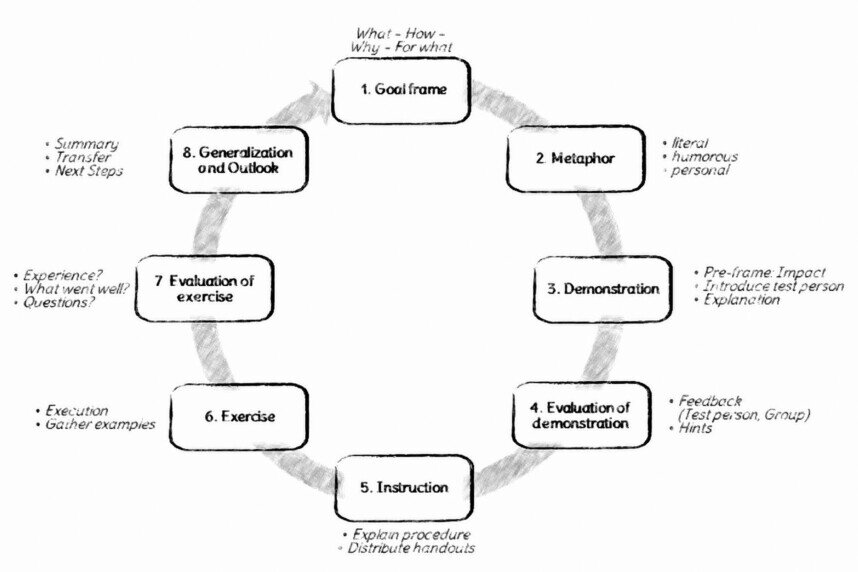Exercise format
The standardized exercise format offers a structure for training units that foster practical learning in workshops, trainings, and similar interactive meetings. Based on an adaptation of the Grinder model by the NLP-Akademie Schweiz, an exercise is divided into eight steps. Participants are introduced into the exercise, accompanied in the execution, and eventually, they discuss the experiences gained. The individual steps' contentual design should be adapted to the target group's needs, i.e., their language, attitudes, and daily routine. The appropriate preparation improves the quality of the exercise and increases the participants' readiness to play an active role.

The exercise format consists of eight steps: Goal frame, Metaphor, Demonstration, Evaluation of demonstration, Instructions, Exercise, Evaluation of exercise, Generalization, and Outlook.
- Goal frame
Participants are prepared in the goal frame for the exercise by explaining the goals. What is it all about? What will be done? What should be achieved? What is the benefit for everybody? Participants are informed that it is an exercise and that the personal outcome increases with active participation.
- Metaphor
The metaphor gives participants an intuitive understanding of the subject. For this purpose, it is recommended to use an emotional story that refers to the exercise and the participants' matter. This can be a narrative or visual transfer of the topic to another meaning area: stories, pictures, symbols, experiences, or the like. These can originate from generally available collections or personal experience.
- Demonstration
Volunteers exercise the procedure in the demonstration exemplarily. The steps of the exercise, the different roles as well as the desired effects are shown. During the demonstration, the trainer points out particularly essential aspects.
- Evaluation of demonstration
After the demonstration, the volunteers describe how they were affected and what they perceived. Participant questions should be clarified thereby.
- Instructions
The exercise's procedure is specified in the instructions in a structured way, the duration specified, and the tasks of each role roles described on a flipchart or a paper-based process description. Definite rules for the exercise facilitate the execution of the practice, e.g., codes of behavior, timeframe. Open questions should be conclusively clarified together.
- Exercise
The participants gather themselves into groups, distribute the roles, and execute the exercise. The trainer remains in the background, observes inconspicuously, collects examples of the exercises' application, and supports if questions arise. The given timeframe should be kept. For this purpose, the trainer controls the procedure with tight time management.
- Evaluation of exercise
After everybody gets back to the plenum, the discussion begins with some observations of the trainer. Then participants exchange their observations and experiences. The more insights that are formulated, the more significant the effect. What did everyone experience? What worked well, and what less well? Which insights did the participants learn? This exchange is an essential part of the exercise because participants become familiar with the colleagues' thoughts and feelings, which is rarely possible in everyday life. The insights are documented on flipcharts.
- Generalization and Outlook
In generalization, the experiences and insights are linked with the professional or private daily routine. Participants find potential fields of application for the new insights by answering the following questions. What did I learn? Where can I use new insights? When is the next opportunity?
The exercises will be more effective, the more practical components and interactions are included. The contents can be better memorized and easier used.

